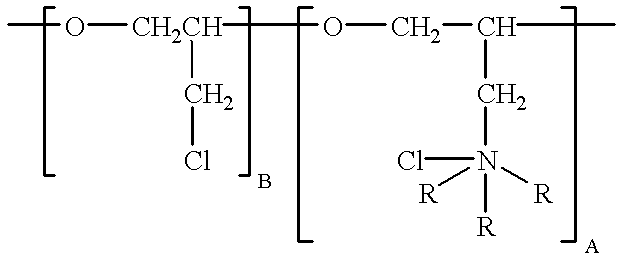Ductility additives for electrorefining and electrowinning
a technology of additives and ductility, applied in the field of additives, can solve the problems of oxides which fall off during electrolysis, impurities of lead in the copper deposit, and additives commonly used tend to oxidiz
- Summary
- Abstract
- Description
- Claims
- Application Information
AI Technical Summary
Problems solved by technology
Method used
Image
Examples
example i
An electrorefining electrolyte is analyzed and has the constituents set forth in Table I below.
TABLE I Copper Electrorefining Electrolyte Constituent Amount Copper Sulfate 180 g / l Sulfuric Acid 150 g / l Chloride Ion 30 mg / l Nickel Ion 15 mg / l Arsenic Ion 6 g / l Ferrous Ion 9 g / l Tellurium Ion 150 g / l All Other Impurities <400 mg / l
To the bath is added 11 mg / l of polyepichlorohydrin trimethylamine quarternary, having a molecular weight of 2,000 and the formula: ##STR3##
The bath is operated at 150.degree. F., at 20 amps per square foot cathode current density. The deposit is ductile and fine-grained with no dendrites.
example ii
A copper electrowinning solution is analyzed to contain the constituents set forth in Table II.
TABLE II Copper Electrowinning Electrolyte Constituent Amount Copper Sulfate 170 g / l Sulfuric Acid 165 g / l Chloride Ion 30 mg / l Nickel 7.5 mg / l Iron 9 g / l Arsenic 10 g / l All Other Impurities <500 mg / l
11 mg / l polyepichlorohydrin trimethylamine quarternary is added to the bath. This constituent has the formula: ##STR4##
where A is about 10 and B is about 1, the compound having a molecular weight of about 2900. The bath is operated at a temperature of 140.degree. F., with cathode current densities of 12 amps per square foot. The resulting electrowinned copper is found to be pure, highly-ductile and fine-grained.
example iii
(Control)
Samples of electrowinning electrolytes were removed from a commercial electrowinning production facility, which has substantially the same chemistry as that set forth in Example I but includes glue, thiourea and avitone, and placed in one liter beakers as a comparative test. This sample is then placed in a suitable electroplating cell and heated to 150.degree. F. A copper is plated onto a passivated stainless steel substrate until a plating thickness of about 4 mils. The foil is cracked and brittle.
PUM
| Property | Measurement | Unit |
|---|---|---|
| concentration | aaaaa | aaaaa |
| concentration | aaaaa | aaaaa |
| concentration | aaaaa | aaaaa |
Abstract
Description
Claims
Application Information
 Login to View More
Login to View More - R&D
- Intellectual Property
- Life Sciences
- Materials
- Tech Scout
- Unparalleled Data Quality
- Higher Quality Content
- 60% Fewer Hallucinations
Browse by: Latest US Patents, China's latest patents, Technical Efficacy Thesaurus, Application Domain, Technology Topic, Popular Technical Reports.
© 2025 PatSnap. All rights reserved.Legal|Privacy policy|Modern Slavery Act Transparency Statement|Sitemap|About US| Contact US: help@patsnap.com



